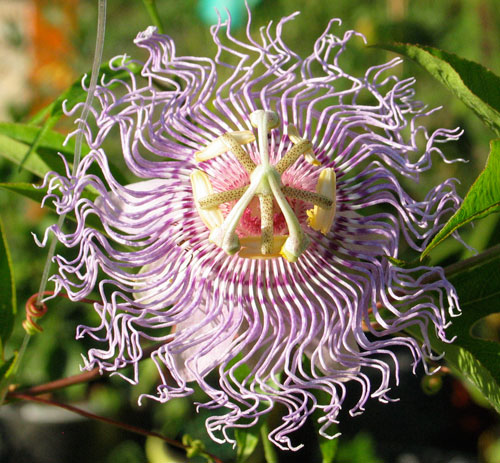Passifloraraceae - syn. Passiflora edulis var. kerii Mast., Granadilla incarnata Medik - Passifloraceae
May Apple, Apricot Vine, Wild Passion Flower, May Pop, May Flower, Fleischfarbene Passionsblume
Perennial vine growing native in southeastern North America, Bermuda, Central America and South America.
Valuable sedative and tranquillising herb with a long history of use in North America.
The German Commission E Monographs, a therapeutic guide to herbal medicine, approve Passiflora incarnata for nervousness. http://buecher.heilpflanzen-welt.de/BGA-Kommission-E-Monographien/passiflorae-herba-passionsblumenkraut.htm
„Passionflower (Passiflora incarnata L.) is used in phytotherapy as a mild sedative and anxiolytic agent. In the literature it is clear this plant shows considerable qualitative and quantitative variability with respect to its content of C-glycosyl flavones, some of which are used as marker compounds for extracts. Analysis of plant material cultivated in Australia revealed two chemically distinct groups; hence an investigation was carried out to determine whether distinct intraspecific chemotypes exist in this species. Eleven P. incarnata samples were analysed by HPLC, LC-MS and two different TLC methods. The samples fell into two distinct groups with respect to their C-glycosyl flavone profile, with little within-group variation. One chemotype was dominated by isovitexin and schaftoside/isoschaftoside, as is most widely reported in the literature for this species. The other chemotype was characterized by a high level of swertisin, with low levels of schaftoside/isoschaftoside. The two chemotypes are readily identified by both HPLC and TLC. Although the compounds responsible for the therapeutic activity of P. incarnata are yet to be identified, phytomedicines should be made with the accepted isovitexin chemotype until the pharmacological implications of chemotypical differences are understood.“
[Pharmacognosy and chemotypes of passionflower (Passiflora incarnata L.).
Wohlmuth H, Penman KG, Pearson T, Lehmann RP. Biol Pharm Bull. 2010;33(6):1015-8]
„… the in vitro effects of a dry extract of Passiflora incarnata (sole active ingredient in Pascoflair® 425 mg) on the GABA system were investigated. The extract inhibited [3H]-GABA uptake into rat cortical synaptosomes but had no effect on GABA release and GABA transaminase activity. Passiflora incarnata inhibited concentration dependently the binding of [3H]- SR95531 to GABAA-receptors and of [3H]-CGP 54626 to GABAB-receptors. Using the [35S]-GTPγS binding assay Passiflora could be classified as an antagonist of the GABAB receptor. In contrast, the ethanol- and the benzodiazepine-site of the GABAA-receptor were not affected by this extract.“
[Modulation of the γ‐aminobutyric acid (GABA) system by Passiflora incarnata L., Appel, K., Rose, T., Fiebich, B., Kammler, T., Hoffmann, C., Weiss, G., Phytotherapy Research, Vol.25(6), 2011, 838-843]


